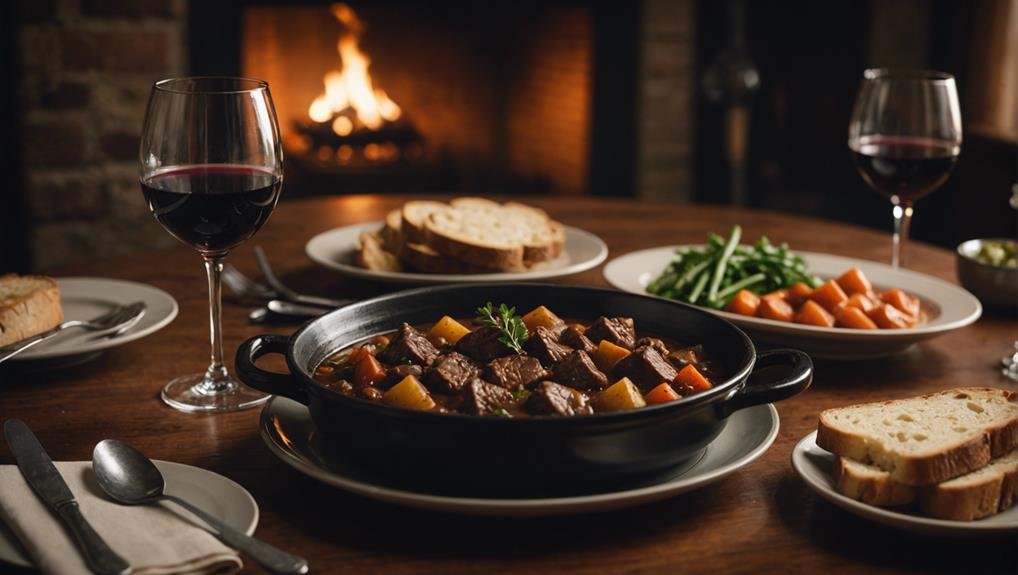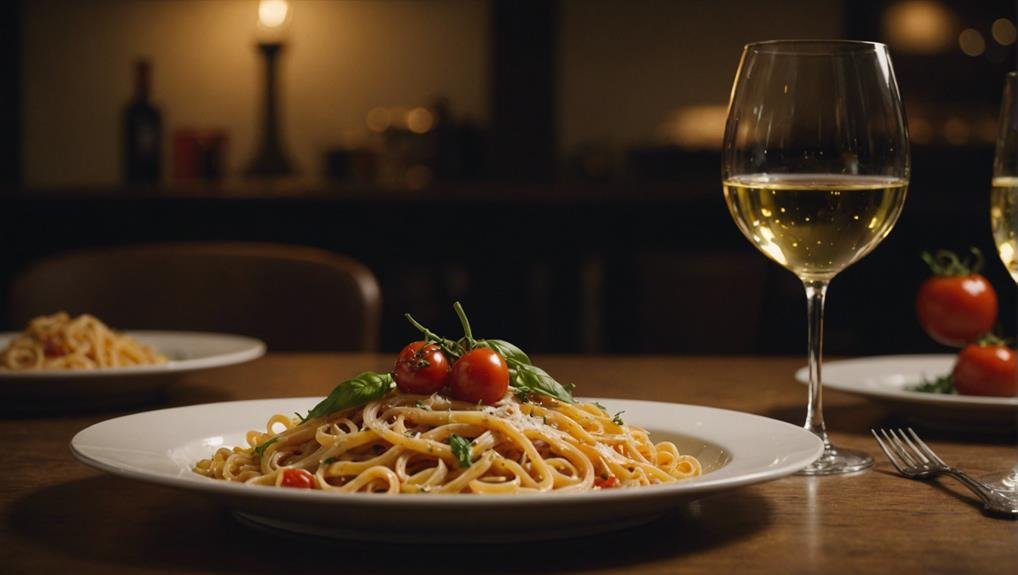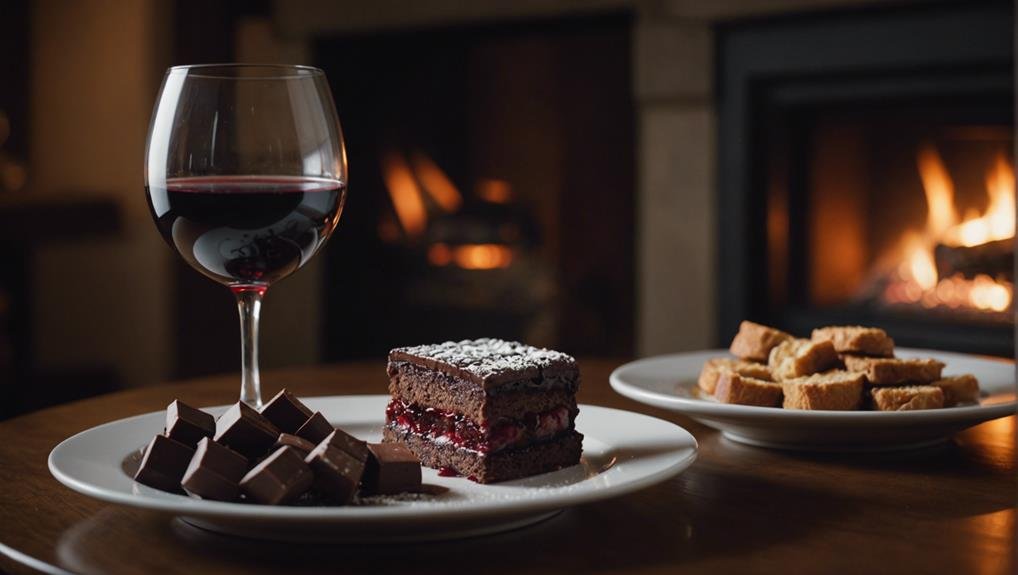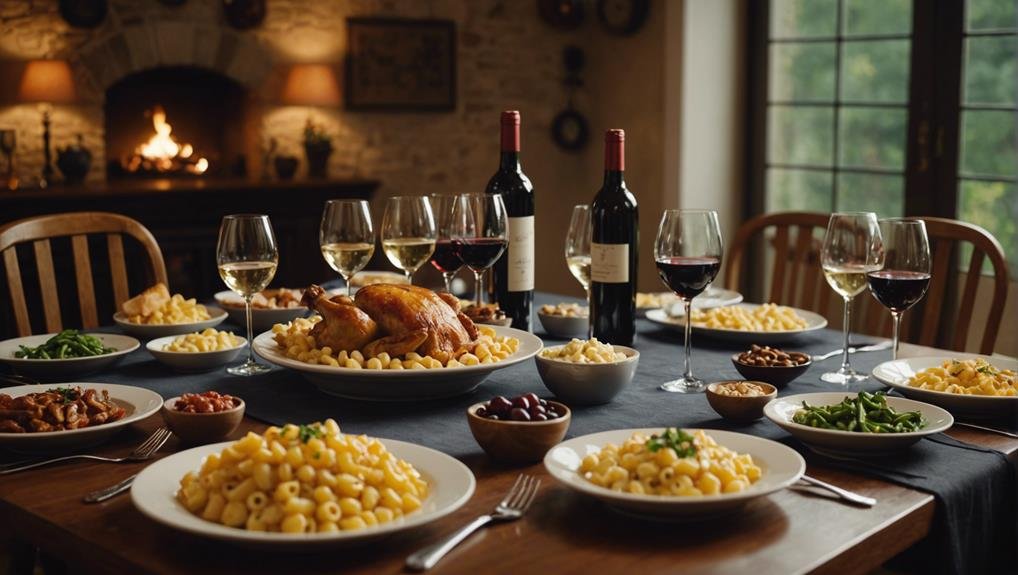Exploring the art of pairing delicious wines with comforting dishes opens up a world of culinary possibilities that can transform a meal into a memorable experience.
When a well-chosen wine meets a familiar comfort food, the blend of flavors and textures can create a sense of warmth and contentment that goes beyond just eating.
Venturing into the realm of wine and comfort food pairings reveals a place where the ordinary becomes extraordinary, and where each sip and bite offer a harmonious symphony to be enjoyed.
Wine Pairing Basics

Understanding how to pair wines with food is essential for creating enjoyable dining experiences. The key to successful wine pairing is balancing the intensity of the wine with the flavors of the dish.
It's also important to consider the acidity levels of the wine to enhance the overall dining experience. Whether you're contrasting or complementing flavors, the goal is to find a harmonious balance that elevates the meal.
Personal preferences also play a significant role in choosing the perfect wine to accompany a dish. By following these basic principles, you can discover delightful flavor combinations that enhance both the wine and the food, creating a more enjoyable dining experience.
Comfort Food Selections
Comfort foods hold a special place in many people's hearts, bringing a sense of nostalgia and satisfaction. Whether it's classic favorites like meatloaf and mashed potatoes or indulgent treats like funnel cake, these dishes evoke feelings of warmth and happiness.
Pairing these comfort foods with the right wine can enhance the dining experience by balancing flavors and elevating enjoyment. Whether you're enjoying a comforting bowl of top ramen or a simple grilled cheese with tomato soup, there are wine choices that can complement and enrich the flavors of these beloved dishes.
Understanding the characteristics of both the food and the wine can create delightful combinations on the palate, making each bite and sip a moment to truly relish.
Acidity's Role in Pairing

Understanding how acidity affects food and wine pairings is crucial for creating delightful dining experiences. Acidity, a key element in wine, plays a significant role in shaping the overall flavor profile and how well it complements different dishes.
Wines with higher acidity can effectively cut through the richness of fatty foods, cleansing the palate and intensifying flavors. When matching acidic wines with dishes, it's important to consider balancing the acidity levels of both the food and the wine to ensure a harmonious blend.
Furthermore, the acidity in wine has the ability to enhance certain flavors in food, revealing hidden taste notes and fostering a more dynamic interaction. By grasping the impact of acidity in pairing, you can enhance your dining experience by creating well-rounded and enjoyable combinations of wines and comfort foods.
Enhancing Wine Tasting Experience
To enhance your wine tasting experience, it's important to focus on sensory evaluation and identifying key characteristics. Start by observing the color and clarity of the wine, then move on to the aroma, noting any fruit, floral, or earthy notes.
When tasting, consider factors like the wine's body, acidity, sweetness, tannins, and finish. Pay attention to flavors such as citrus, berries, or spices, and take note of how the wine feels in your mouth – whether it's smooth, velvety, or crisp.
Experimenting with different wine styles and regions can help broaden your palate and enrich your experience. The more you practice and expose yourself to various wines, the deeper your understanding and appreciation for the complexities of wine will become, ultimately enhancing your enjoyment.
Principles of Successful Pairings

When it comes to pairing wine with food successfully, it's crucial to consider balancing flavors and matching intensities for a delightful dining experience. Several key principles play a role in achieving this harmony:
- Matching Wine Strength: Ensure the wine's robustness aligns with the dish's intensity.
- Considering Acidity: Choose wines with acidity that complements or contrasts with the food.
- Flavor Interplay: Opt for wines that either enhance the dish's flavors or provide a contrasting balance.
- Cooking Methods: Tailor wine choices based on how the food is prepared.
- Personal Preference: Acknowledge individual tastes and preferences in creating successful pairings.
Understanding Wine Production
Understanding the process of wine production can greatly enhance the principles of successful wine and food pairings. Wine production involves several key steps, including grape cultivation, fermentation, aging, and quality assurance.
It all begins with carefully caring for grapevines, selecting the optimal time for harvesting, and fermenting the grape juice to create wine. The aging process in barrels or tanks adds depth and richness to the final product. Quality assurance ensures that the wine meets specific standards before it is bottled and labeled.
Exploring Wine Styles

When it comes to wine, there's a wide array of styles to explore, each offering unique flavors and characteristics to suit different tastes and occasions.
- Red Wines: These wines are known for their rich and robust flavors, such as black cherry and tobacco. Popular examples include Cabernet Sauvignon, Merlot, and Pinot Noir.
- White Wines: Crisp and refreshing, white wines often feature notes of citrus and tropical fruits. Varieties like Chardonnay, Sauvignon Blanc, and Riesling are well-loved choices.
- Rosé Wines: With their pink hues and a blend of red and white wine traits, rosé wines are versatile and enjoyable. Grenache, Syrah, and Sangiovese rosés are commonly appreciated.
- Sparkling Wines: Effervescent and perfect for celebrations, sparkling wines range from dry to sweet. Champagne, Prosecco, and Cava are among the top picks in this category.
- Dessert Wines: Indulge in the sweet and luscious flavors of dessert wines, ideal for post-dinner delight. Options like Port, Sauternes, and Ice Wine offer a perfect ending to a meal.
Perfecting Wine and Food Harmony
Creating a perfect harmony between wine and food flavors is essential for an exceptional dining experience. This balance involves ensuring that the wine complements or enhances the dish's flavors, aligning the wine's intensity with the richness of the food, considering how the acidity in the wine interacts with the dish, and pairing wines with textures that either enhance or contrast the food's texture.
Achieving this harmony results in a delightful and satisfying meal where the wine and food work together seamlessly to elevate the overall dining experience.
Frequently Asked Questions
Can the Shape of a Wine Glass Affect the Taste of the Wine?
The shape of a wine glass can significantly affect the taste of the wine. Glassware tailored to specific varietals helps to channel aromas and flavors towards the nose and palate, enhancing the overall tasting experience by effectively highlighting the wine's characteristics.
What Are Some Common Wine Faults to Watch Out For?
Some common wine faults to watch out for include cork taint, which gives off a musty smell, oxidation that can turn the wine brown and taste stale, and volatile acidity leading to vinegar-like aromas. Brettanomyces contamination may result in barnyard scents, while sulfur faults can produce unpleasant odors in the wine.
How Does Altitude Affect the Flavor of Wine Grapes?
Altitude plays a significant role in shaping the characteristics of wine grapes by affecting factors like temperature, sunlight exposure, and oxygen levels. At higher altitudes, the cooler climate leads to slower ripening of grapes and higher acidity levels. These conditions can contribute to the development of more complex flavors in the wine.
Is There a Specific Way to Hold a Wine Glass for Optimal Tasting?
To enjoy the full flavor of your wine, hold the glass by the stem. This simple technique helps maintain the wine's temperature, prevents smudges on the glass, and allows you to admire the color and savor the aromas and flavors more effectively.
Do Different Wine Closures Impact the Aging Potential of the Wine?
Different wine closures have a direct impact on how wine ages over time. Cork closures allow a controlled amount of oxygen to interact with the wine, facilitating the aging process. On the other hand, screw caps limit the oxygen transfer, which helps preserve the freshness of the wine but may hinder its aging potential. Synthetic corks, while offering consistency, lack the ability to regulate oxygen exposure. It's essential to consider the closure type when thinking about how a wine will evolve and develop its flavors.
Conclusion
Pairing delicious wine with comfort foods can greatly enhance your dining experience by creating a perfect balance of flavors.
For instance, enjoying a rich and creamy macaroni and cheese with a crisp and acidic Sauvignon Blanc can truly elevate the flavors of both the dish and the wine.
By understanding the key principles of successful pairings and exploring various wine styles, you can achieve a delightful harmony between your wine and food choices, making each dining experience truly enjoyable.